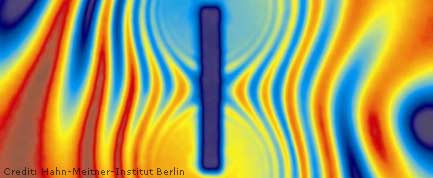Magnet Therapy Gets Boost from Real Study

Magnetic therapy, long derailed as pseudoscience, has just gotten a boost from a biomedical study showing how magnets can reduce swelling.
The study will likely impress manufacturers of magnetic devices, many of whom never dreamed these things could actually work and have been selling them merely to cash in on this $5-billion-a-year industry. But skeptics will have a tough time brushing this one off.
In a tightly controlled study—a rarity in the world of alternative medicine—Thomas Skalak of the University of Virginia found that static magnets reduced swelling by up to 50 percent in the tiny hind paws of rats. Skalak published his results in the November issue of the American Journal of Physiology.
Push and pull
Therapeutic magnets have a demonstrated ability to pull wads of cash from your wallet. Some magnetic back braces sell for upwards of $100. The benefits associated with magnets range, according to proponents, from curing cancer to chasing away your mother-in-law, but mostly magnets are used to treat pain from muscle aches and arthritis.
Called static because they emit a steady force, similar to a refrigerator magnet, therapeutic magnets are very popular among athletes. Former Miami Dolphins quarterback Dan Marino claims that magnets healed his fractured ankle later in his career. It's not clear, however, which losing season he was referring to.
Yet little scientific evidence exists demonstrating that static magnets heal, according to the National Center for Complementary and Alternative Medicine (NCCAM), which funds studies of questionable therapies to see if there's anything behind the often outrageous claims.
Get the world’s most fascinating discoveries delivered straight to your inbox.
First strong study
Performing high-quality magnet studies has been difficult, mainly because patients easily can test whether they are wearing a real magnet or a placebo simply by seeing if a paperclip sticks to it. Also, pain is subjective, so studies measuring pain reduction can be biased. As a result, according to NCCAM, the few magnet studies showing positive health effects have had major flaws.
Skalak, funded by NCCAM, took the novel approach of working with rats to determine changes in body function as a result of wearing static magnets or sham magnets. Smart as they might be, the rats did not seem to know the difference. He induced different kinds of swelling and noted that an external magnet with a strength of 700 gauss, 10 times stronger than a refrigerator magnet, reduced the type of swelling associated with bee stings or sprains.
The swelling reduction was strongest when the magnet was applied immediately. Skalak envisions sports trainers using magnetic wraps instead of ice packs.
How it works?
Skalak and his colleague, Cassandra Morris, also at the University of Virginia, can't explain how therapeutic magnets work. In fact, no one can.
One theory, often cited by advocates, is that magnets attract the iron in blood and increase blood flow. But blood iron is locked up in hemoglobin molecules, which are slightly repelled by magnets. Other theories are just wacky, such as the reasoning that city dwellers are magnetically deprived because pavements block the earth's natural magnetic field.
It's a good thing blood isn't affected much by magnets, because if blood were greatly affected, then when inside an MRI device, which employs alternating magnetic fields 100 times stronger than a therapeutic magnet, you would blow up.
One plausible theory, Skalak said, is that the magnetic field might alter calcium channels in muscle cells, which could cause arteries to dilate.
What it doesn't mean
Skalak stopped short of endorsing any commercial product, because what he found was based on a specific magnetic field strength for a specific swelling at a specific distance below the skin. In the commercial world, there is no established "dose" of magnetic fields.
Commercial therapeutic magnets come in a range of strengths, many no stronger than a refrigerator magnet. You can test the strength of one: Place a sock over a magnetic shoe insert and you'll see that it no longer holds a paperclip. That magnetic field has to penetrate both sock and skin to have an effect. Wrapping a refrigerator magnet in an ace bandage will get you just as far at a fraction of the price.
Magnetic field strengths drop sharply with distance, inversely proportional with the cube of the distance. So it is unclear if a magnetic pad can reach as deep as the spine.
Skalak also said that his study in no way supports copper or titanium bracelets or healing crystals. But it is only a matter of time before shysters latch on the Skalak's work as proof of the efficacy of their zany health products.
- Top 10 Bad Things That Are Good For You
- The Most Popular Myths in Science
- Take the Body Quiz
Christopher Wanjek is the author of the books “Bad Medicine” and “Food At Work.” Got a question about Bad Medicine? Email Wanjek. If it’s really bad, he just might answer it in a future column. Bad Medicine appears each Tuesday on LiveScience.

Christopher Wanjek is a Live Science contributor and a health and science writer. He is the author of three science books: Spacefarers (2020), Food at Work (2005) and Bad Medicine (2003). His "Food at Work" book and project, concerning workers' health, safety and productivity, was commissioned by the U.N.'s International Labor Organization. For Live Science, Christopher covers public health, nutrition and biology, and he has written extensively for The Washington Post and Sky & Telescope among others, as well as for the NASA Goddard Space Flight Center, where he was a senior writer. Christopher holds a Master of Health degree from Harvard School of Public Health and a degree in journalism from Temple University.


